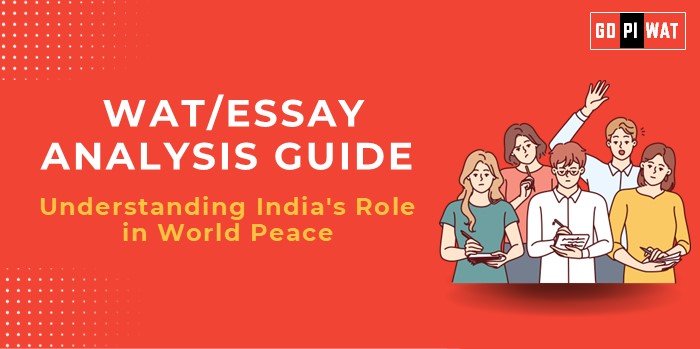📝 Written Ability Test (WAT)/Essay Analysis Guide
🌐 Understanding India’s Role in World Peace
India’s contributions to global peace, particularly through its peacekeeping initiatives and non-alignment policy, resonate with its historical values of non-violence and diplomacy. Writing on this topic involves discussing its evolving role in a complex global environment marked by geopolitical challenges.
📊 Effective Planning and Writing
- ⏱️ Time Allocation:
- Planning: 5 minutes to brainstorm key achievements and challenges.
- Writing: 20 minutes to develop structured arguments.
- Review: 5 minutes to refine for clarity and coherence.
💡 Introduction Techniques for Essays
- Contrast Approach: “While India champions peace on the global stage, its complex regional relations sometimes hinder its objectives, creating a unique dynamic in its international strategy.”
- Solution-Based Approach: “With a firm stance on non-alignment and a commitment to peacekeeping, India’s evolving role in global peace offers a framework for other nations.”
- Timeline Approach: “From its non-alignment roots to modern-day peacekeeping, India has remained a steady proponent of global peace.”
🔍 Structuring the Essay Body
- Achievements:
- 🌍 Focus on peacekeeping missions, nuclear policy restraint, and diplomatic initiatives like “Neighborhood First” and “Act East.”
- 📊 Support with data such as troop numbers and India’s leadership in peace dialogues.
- Challenges with Comparative Analysis:
- ⚠️ Discuss issues like border conflicts and limitations in global decision-making.
- 🧩 Compare with countries like Norway and Japan, which have different but complementary peace-building roles.
- Future Outlook:
- 🚀 Suggest possible improvements such as a greater role in the UN, stronger diplomatic ties, and peace-building partnerships.
✅ Concluding Effectively
- Balanced Perspective: “India’s peace efforts reflect its values and strengths, but regional issues necessitate diplomatic agility and international partnerships.”
- Comparative Example: “Much like Norway and Sweden, India’s peace-building efforts demonstrate the power of consistent commitment, even amid geopolitical complexities.”
🔎 Analyzing Successes and Shortcomings
- Key Achievements: High engagement in UN peacekeeping, moral leadership in non-proliferation, successful neighborhood diplomacy.
- Ongoing Challenges: Regional tensions, limited permanent influence in global councils, and resource constraints.
- Global Context: India’s role mirrors the peaceful diplomacy seen in Scandinavian countries and Japan, where non-aggression shapes international engagement.
💭 Recommendations for Sustainable Progress
- 🤝 Stronger Regional Partnerships: Collaborate with neighboring countries for conflict resolution frameworks.
- 🗳️ Increased Advocacy in the UN: Seek a permanent seat on the UN Security Council to influence peacekeeping decisions.
- 🎭 Investment in Soft Power: Promote cultural and educational exchanges to foster goodwill globally.
📄 Sample Short Essays on India’s Role in World Peace
- Balanced Perspective: “India’s peacekeeping role is central to its foreign policy, and while regional conflicts pose challenges, its unwavering commitment to non-violence positions it as a unique contributor to global peace.”
- Solution-Oriented: “By strengthening its UN participation and deepening regional partnerships, India can overcome current limitations and expand its peace-building impact.”
- Global Comparison: “Similar to Scandinavian nations, India’s peace efforts underscore the power of moral leadership in an increasingly polarized world.”


